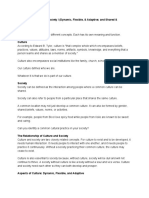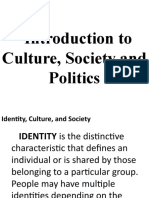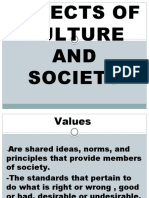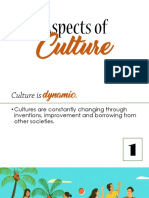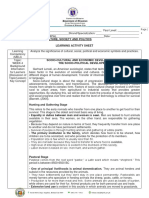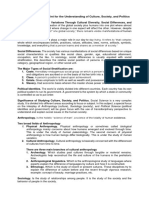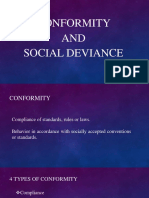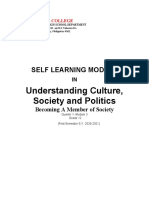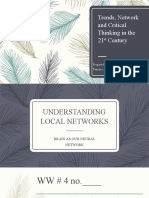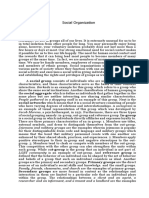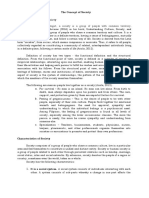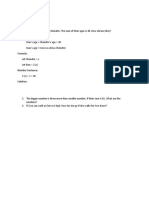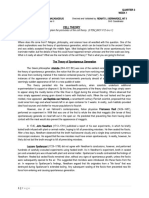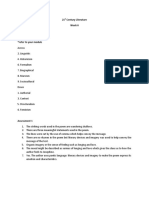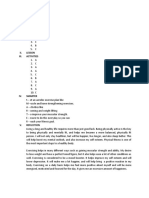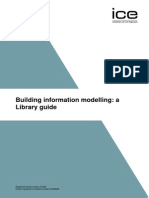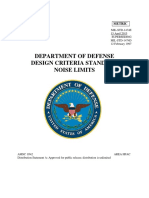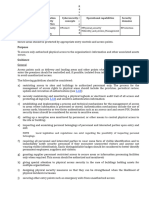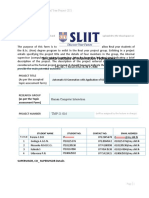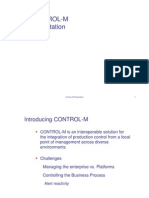Data Center College of the Philippines
Ubbog Lipcan, Bangued, Abra
Subject: Understanding Culture, Society and Politics
Instructor: Shenna Balicas – Baga
LESSON 2
The Concept of Society
Meaning and Nature of Society
According to sociologist, a society is a group of people with common territory, interaction, and
culture. Arcinas (2016) in his book, Undertanding Culture, Society, and Politics, defined society
as group of people who share a common territory snd culture. It is a group of people living
together in a definite territory, having a sense of belongingness, mutually interdependent of each
other, and follow a certain way of life. Society is derived from the Latin term “societas”, from
socius, which means companion or associate. Thus, it refers to all people, collectively regarded
as constituting a community of related, interdependent individuals living in a definite place,
following a certain mode of life (Ariola, 2012).
Definition of society has two types - the functional definition and the structural definition. From
the functional point of view, society is defined as a complex of groups in reciprocal
relationships, interacting upon one another, enabling human organisms to carry on their life-
activities and helping each person to fulfill his wishes and accomplish his interests in association
with his fellows. From the structural point of view, society is the total social heritage of
folkways, mores and institutions; of habits, sentiments and ideals. The important aspect of
society is the system of relationships, the pattern of the norms of interaction by which the
members of the society maintain themselves.
The following are reasons people live together as a society (Ariola, 2012):
a. For survival – No man is an island. No man can live alone. From birth to death, man always
depends upon his parents and from others. The care, support, and protection given by them are
important factors for survival.
b. Feeling of gregariousness – This is the desire of people to be with other people, especially of
their own culture. People flock together for emotional warmth and belongingness. The need for
approval, sympathy and understanding to which the individual belongs is a psychosocial need.
Among Filipinos, the feeling of gregariousness is found in all levels of society, especially among
the lower socio- economic classes. The more the person is needy, the more he craves sympathy
and understanding from someone else.
c. Specialization – Teachers, businessmen, students, physicians, nurses, lawyers, pharmacists,
and other professionals organize themselves into societies or associations to promote and protect
their own professions.
Characteristics of Society
Society comprises of a group of people who share a common culture, live in a particular area and
feel themselves to constitute a unified and distinct entity. Society or human society is a group of
�people related to each other through persistent relations such as kinship, marriage, social status,
roles and social networks. By extension, society denotes the people of a region or country,
sometimes even the world, taken as a whole. Society has the following characteristics:
1. It is a social system. A social system consists of individuals interacting with each other. A
system consists of sub-parts whereby a change in one part affects the other parts. Thus, a change
in one group of individuals will affect the stability of the other parts of the system.
2. It is relatively large. The people must be socially integrated to be considered relatively large
than if the people are individually scattered. Thus, the people in a family, clan, tribe,
neighborhood, community are socially integrated to be relatively large in scope.
3. It socializes its members and from those from without. Since most of society’s members
are born to it, they are taught the basic norms and expectations. Those who come from other
societies, before being accepted as functioning members, are socialized and taught the basic
norms and expectations of the society.
4. It endures, produces and sustains its members for generations. For society to survive, it
must have the ability to produce, endure and sustain its new members for at least several
generations. For instance, if a society cannot assist its members during their extreme conditions
of hunger and poverty, that society will not survive long.
5. It holds its members through a common culture. The individuals in a society are held
together because that society has symbols, norms, and values, patterns of interaction, vision and
mission that are commonly shared by the members of such society.
6. It has clearly-defined geographical territory. The members in a society must live in a
certain specific habitat or place and have a common belongingness and sense of purpose.
Major Functions of Society
A society is important because they have the following functions:
1. It provides a system of socialization. Knowledge and skills, dominant patterns of behavior,
moral and social values, and aspects of personality are transmitted to each members, especially
to the young. The family, the peer group, the school, the church and other government and non-
government organizations play a role in the individual’s development.
2. It provides the basic needs of its members. Food, clothing, shelter, medicine, education,
transportations and communication facilities, among others must be provided by society to
satisfy the basic needs of its members.
3. It regulates and controls people’s behavior. Conformity to the prevailing norms of conduct
ensures social control. The police, armed forces, law enforcement agencies and even the church
and other government and non-government organizations exist as means of social control. Peace
and order are created through a system of norms and formal organizations.
�4. It provides the means of social participation. Through social participation, the individuals in
a society learn to interact with each other, present and discuss their concerns and solve their own
problems or renew their commitment and values. the people are give the opportunities to
contribute to their knowledge and skills for the betterment of their family, neighborhood and
community. religious organizations, civic organizations, people’s organizations (PO) and non-
government organizations (NGOs) do their part in community developement.
5. It provides mutual support to the members. Mutual support is provided to the members of
society in the form of relief in any form and solution to problems met by them. This form of
assistance may come from the family, neighbors, clans, government and non-government
agencies, civic and religious organizations.
Types of Societies
Societies exist in particular places and times, and they change over time. Societies are organized
in particular patterns, patterns that are shaped by a range of factors, including the way people
procure food, the availability of resources, contact with other societies, and cultural beliefs. For
example, people can change from herding to farming only if they have the knowledge, skills, and
desire to do so and only in environments that will support agriculture. As societies develop,
changes take place in the social structures and relationships between people that characterize
each type of society. For example, in industrialized societies, relationships between people
typically must become more formal because people must interact with strangers and not just
relatives. It is important to note that not all societies go through all stages. Some are jolted into
the future by political events or changes in the global system, and some resist pressures to
become modernized and continue to live in simpler social systems.
Sociologists and anthropologists (experts who study early and tribal cultures) identified different
types and classification of societies. Below are the different types of societies as mentioned by
Ariola (2012) in his book Sociology and Anthropology with Family Planning:
According to Economic and According to Evolutionary According to People’s
Material System View Substinence
1. Pre-class Societies – They 1. Simple Societies – These 1. Food Gathering Societies
are characterized by were predominantly small, (more than 16, 000 years ago)
communal ownership of nomadic and leadership is – The people survived from
property and division of unstable. The people had no day to day through hunting
labor. Examples of these specialization of skills, thus larger animals, collecting
societies are earliest clans and they lived in a simple life. shellfish and vegetable
tribes. gathering. Their tools were
made of stones, wood and
bones
2. Asiatic Societies – 2. Compound Societies – 2. Horticultural Societies
The people are economically Two or more simple societies (12, 000 to 15, 000 years ago)
self-sufficient but their merged to form a new and - The people planted seeds as
leaders are despotic and bigger society. These a means of production for
� powerful. societies tended to be subsistence.
predominantly settled
agricultural societies and
tended to be characterized by
a division of four or five
social classes.
3. Ancient Societies – These 3. Doubly Compound 3. Pastoral Societies – Most
are characterized by private Societies – These are of the people are nomadic
land ownership. The rich completely integrated, more who follow their herds in
(those who haves) owned big definite in political and quest of animals for food and
tract of private properties religious structure and more clothing to satisfy their needs.
while the poor (those who- complex division of labor. they raised animals to provide
have-nots) worked as Considerable progress in milk, fur and blood for
laborers. Thus, wealth is infrastructure and knowledge protein. These societies
limited to a few people in arts had taken place typically are relatively small,
wandering communities
organized along male-
centered kinship groups.
4. Feudal Societies – The 4. Militant Societies – These 4. Agricultural Societies – In
aristocrats (feudal lords) are characterized by the the early agricultural
owned the wealth of the following: (a) the existence of societies, people used plow
country due to their military organization and than hoe in food production.
ownership of big tracts of military rank; (b) individual By the use of plow, it turns
lands. The peasants worked lives and private possessions the topsoil deeper allowing
on the lands of the feudal are at the disposal of the for better aerating and
lords with only few benefits State; and (c) individual fertilizing thus improving
received by them. However, activities such as recreation, better yield when harvested.
these types of societies movements, satisfaction of Irrigation farming was
collapsed due to the rise of biological needs, and introduced which resulted to
cities and metropolis as a production of goods are a larger yield of production
result of the rise of trades and totally regulated by the State. that can even feed large
industries In other words, individuals number of people who did not
exist to serve the State know how to produce food by
themselves
5. Capitalists Societies – 5. Industrial Societies – 5. Industrial Societies -
These societies existed in These societies are These societies began in the
societies where two classes of characterized by the 18th century during the
people appeared. The following: Industrial Revolution and
bourgeoisie (property (a) people elect their gained momentum by the turn
owners) who owned the representatives to protect of the 19th century. This
capital and the means of their individual initiatives; period is characterized by the
production and the proletariat (b) freedom of belief, use of machines as means of
(the laborers or workers) who religion, production of food production. Mass
are compelled to work for the industrial goods exist; production of guns, invention
capitalists or sell their small (c) disputes and grievances of steam locomotives and
properties to the capitalists are settled through peaceful large production of well-
� arbitration; and (d) business coordinated labor force took
organizations appear where place. Thus, the people began
cooperative efforts between to be highly skilled and
management and labor are highly diversified in their
based on contractual occupation.
agreement. In other words,
individual freedom, rights
and initiatives are being
protected.
6. Democratic Societies – 6. Post-Industrial Societies 6. Post-Industrial Societies
These societies are – These are characterized by: or Information Societies –
characterized by free (a) spread of computer Information and
enterprise where people are machines and existence of communication technology is
free to engage in any lawful information and the hallmark of these modern
business for profit or gain. communication societies. These are
People had to work on their (b) inventions and characterized by the spread of
own livelihood accoeding to discoveries in medicines, computer technology,
what the law mandates. agriculture, business whether advances in this technology
in physical and natural are made by highly-trained
sciences emerged; and computer specialists who
(c) pollution, diseases, work to increase the
calamities are prevalent as a capabilities of computers and
result of the use of advanced internet. The use of modern
technology technology gave rise to
several technological
problems such as pollution,
lung illness, skin problems
and other
Dissolution of a Society
There are several ways by which a society is dissolved: (1) when the people kill each other
through civil revolution; (2) when an outside force exterminates the members of the society; (3)
when the members become apathetic among themselves or have no more sense of belongingness;
(4) when a small society is absorbed by a stronger and larger society by means of conquest or
territorial absorption; (5) when an existing society is submerged in water killing all the people
and other living things in it; or (60 when the people living in such a society voluntarily attach
themselves to another existing society.




